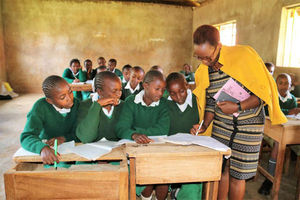
An installation of a figure symbolising baby Jesus lying amidst the rubble in a grotto ahead of Christmas at the Evangelical Lutheran Church in Bethlehem in the Israeli-occupied West Bank on November 25, 2024.
As the world welcomes the 2024 Christmas season, the spotlight turns sharply on Bethlehem, the tiny but iconic ‘Christmas City’ where Jesus of Nazareth was born as a source of inspiration for urban renewal worldwide. The Nazarethian was, certainly, the most unlikely world-changer.
This first-century itinerant preacher, community mobilizer and inventor (carpenter) has become the most influential figure in human history, revered by over 32 per cent of the world’s 8.2 billion people who follow Christianity.
Despite this, few recognise him today as the most powerful influence in the transformation of the urban space as an arena of justice, development and poverty eradication. He, certainly, was. His teachings continue to inspire reforms in the world’s over 10,000 cities today. Bethlehem looms large in the minds of over 2.6 billion Christians and millions other non-Christians worldwide who rest or decide to paint the town red over Christmas.
The urban space of Bethlehem is the core of the Christmas narrative of people and power. As a guest speaker at the 2024 Beijing Forum on “Swift Response to Public Complaints” on December 18-20, 2024, it is this rendition of the power-people nexus in the Christmas story that gripped my thoughts. At its conclusion, the forum adopted the “Beijing Declaration on Urban Governance Modernization,” a new deal to build a “community of global smart cities with a shared future.”
City of God
Clearly, the ‘Beijing Declaration’ shared the Christmas hope for a just, people-centered ‘City of God’. At his birth in Bethlehem, as a preacher in Jerusalem and its surrounding cities, towns and hamlets and as the world’s most famous victim of crucifixion as a savage method of capital punishment by the Romans, Mary’s boy child inspired the shared values that ought to form the moral foundation of our cities. The boy would champion the rights of women, children and minorities as well as care for the poor, needy, sick and the disabled. His teachings have inspired the establishment of schools, hospitals and universities, art and science and propelled anti-slavery movements and mighty revolutions for greater human freedom.
Mega-cities like London, Beijing and Madrid may have embraced digital technologies in their governance today, a people-centered and service-oriented approach to public governance is still a bridge too far. Many modern cities are still unresponsive to the concerns of their residents as Bethlehem at the birth of Jesus.
Bethlehem was all about power, not people. The town was a far cry from the just, inclusive and responsive city envisaged by the Beijing Declaration, the United Nation’s New Urban Agenda or the UN Sustainable Development Goal number 11 on making cities inclusive, safe, resilient and sustainable. Under the power of the Romans and their local Herodian client rulers, Bethlehem and other Judean cities lacked of vital services and exhibited repression and mass poverty.
At the birth of Jesus, Bethlehem was not a bustling metropolis. Instead, it was a relatively small town of nearly 1,000 inhabitants and covering just a few square kilometers. Bethlehem’s urban life centered on a main street, small houses, workshops, a central marketplace, a synagogue, and a few small inns to accommodate the occasional travelers.
The city owed its fame to its historical and cultural significance as the native city of King David and as the cradle of the Jewish monarchy. Here, David was born and anointed king of Israel by the prophet Samuel (I Samuel 16). The town also had a uniquely gendered history. It was the burial-place of Rachel, one of the wives of Jacob and a founding matriarch of Israel who died on the wayside near the city (Genesis 35:19). Bethlehem is also the setting for the book of Ruth, a Moabite woman who married into an Israelite family and eventually converted to Judaism, becoming the great-grandmother of King David and an ancestor of Jesus. The birth of Jesus in the city added to its reputation as “the Christmas City.”
Bethlehem also thrived mainly on its farmers and herders. Not surprisingly, the name “Bethlehem” is translated as the “house of meat” (in Arabic) or “House of bread” (in Hebrew). The town also had its own artisans who produced a range of goods, from pottery and textiles to metalwork and woodcarvings, selling their wares in the local marketplace or to passing travelers.
The city also benefited from its proximity to the great metropolis of Jerusalem, located only 8km south of to the Capital of Judea (now in the Palestinian West Bank) with a permanent population of 25,000-30,000 people — which would swell to possibly 180,000 or more during major festivals — then covering about 140,000 square meters. Bethlehem was also located along major trade routes that connected it to the market of an estimated 1-2.5 million people in Judea and surrounding areas.
Bethlehem’s growth into a great metropolis was stifled by generations of repressive power. For instance, some 135 years before the birth of Jesus, the Romans stationed a garrison there to quell revolts and contain Jewish nationalism. In their quest for big data for the purpose of taxation, the Roman authorities ordered the census requiring Judeans to be counted in their native towns.
The parents of Jesus, Joseph and Mary, descendants of King David, travelled to Bethlehem to be numbered. Nativity revealed the problems of housing and accommodation. At the time of Jesus’s birth, travellers from near and far came to Bethlehem, taking up all inns and caravansaries in town. Joseph could not find shelter for his family and only secured a stable on the outskirts of the town. Christmas gives a hint about the poor state of maternal healthcare.
The birth of Jesus swayed Bethlehem’s fortunes and the ebb and flow of its population. It grew from a tiny town to rival other regional cities, becoming a major destination of pilgrims coming to honour Jesus. Among the earliest of these pilgrims were the three wise men (Magi) who travelled to the town to gift Jesus after his birth, bearing gold, frankincense, and myrrh. Today, Bethlehem has an estimated population of 25,000-43,100 people.
However, the Christmas message of the birth of the ‘king of the Jews’ rattled King Herod who tried to have Jesus killed to eliminate any threat to his power. The nativity story ends with the family of Jesus fleeing to exile in Africa (near Cairo in Egypt) for safety. Christmas is inspiring urban renewal based on the idea of a people-centred ‘city of virtue’ delivering services to citizens.
Professor Peter Kagwanja is Chief Executive at the Africa Policy Institute (API) and Adviser on Governance and Strategy.









